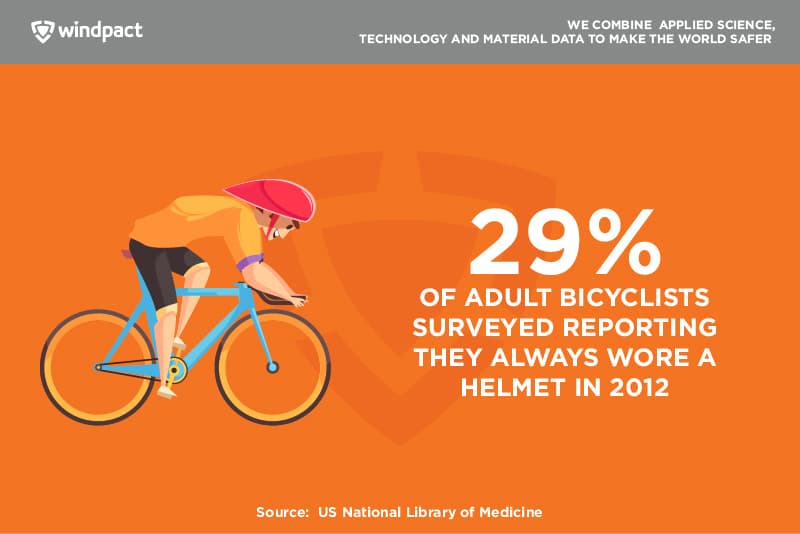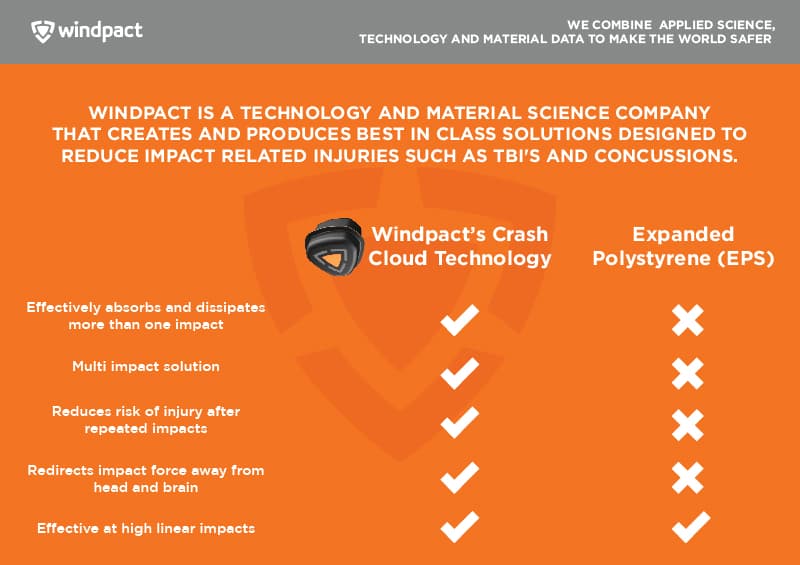Crash Cloud Handles Repeated Impacts Better Than EPS Alone
Introduction
Helmets are meant to be the first line of protection against impacts that happen suddenly. You hear it time and time again how wearing a helmet is a non-negotiable, key safety prerequisite for playing sports, riding bikes, skateboarding, and more.
Alarmingly, a surprising amount of casual sports players forgo helmets with only 29% of adult bicyclists surveyed reporting they always wore a helmet in 2012. Their importance for not only casual athletes but also for professional sports is well-known and the subject of numerous regulations and research initiatives.

When helmets are used, the risk of concussion and severe head injury is greatly reduced, yet not completely eliminated. Reasons for this are unclear, though it is evident that helmet effectiveness over time plays a role. How effective a helmet is at reducing the risk of concussion and skull fracture over time depends on the shell material, design, and type of padding used. Naturally, understanding how repeated impacts affect helmet integrity, as well as offering proprietary solutions, is critical for saving lives.
Windpact remains at the forefront of finding the answers to improving helmet design and safety.
We will be reviewing:
- How the most common foam shock absorption fails after multiple hits
- Why harder shells with more padding are not always optimal choices
- How the Crash Cloud is meeting the challenge of offering protection at all impact severities.
Expanded Polystyrene Fails After Repeated Impacts
The most common type of foam padding lining a majority of helmets today is expanded polystyrene (EPS). This type of padding is a popular choice for many manufacturers due to its affordability and variety of applications. EPS performs well against initial impacts in that it is a crushable foam, responding well and distributing energy when being met with sufficient force.
However, while helmets that use EPS are sturdy and are proven to withstand medium-high impacts, their effectiveness diminishes after repeated blows. A recent study conducted by the KTH Royal Institute of Technology found that alpine ski helmets lined with EPS failed more frequently after repeated low impacts versus other materials.
Impacts are rarely a single event outside of baseball hit by pitches. In football, for example, players can be hit multiple times in the head during a single game, meaning that those helmets could theoretically lose their protective power during this period. Within this framework, you may wonder why EPS has remained such a popular choice; the answer lies in how EPS takes damage and redirects energy by virtue of its ability to crumple.
Think about it this way: most vehicles are designed with a crumple zone, an area that is meant to fail in order to disperse impact force as effectively as possible. This principle is reflected in automobiles and even trains. EPS works under the same logic, where it “falls apart” structurally to absorb energy.
This, however, poses several challenges:Since the EPS within the helmet has already crumpled once, it will absorb shock less effectively the next time around.
- EPS does not reconstitute itself after failure.
- The resulting impact will then have its force redirected to the head and brain rather than throughout the EPS, since it can no longer absorb the same amount of energy.
The result is that helmets that use only standard EPS run into the issue of diminishing returns each time an impact has occurred.

Harder shells are not always better
The first answer that usually comes up when searching for solutions that provide better safety for athletes is to simply add more padding and more material. While this may be a viable option for guarding against extremely hard impacts, the story gets more complicated as we look at mild impacts.
Mild acceleration injuries are surprisingly extremely concussive, possibly due to the lack of intensive research on brain injury at lower velocity events. The brain, being buoyant, floats within a pool of cerebrospinal fluid that prevents tissue from coming into contact with the dura mater. During a concussion, there are times where the brain moves in a different direction and speed from that of the whole head, causing the brain to crash against the inside of the skull; this mechanic possibly underlies many TBI diagnoses after seemingly mild impacts.
The problem with adding more sturdier, harder shell material is that these do little to maximize the safety of your brain during a concussive event. Foam materials must account for mild cushioning that allows the head to move ever so slightly, softening the strain placed on the brain. Thus, we need to strike a delicate balance between softening, protecting against, and absorbing energy from impacts. This is a balancing act that standard EPS configurations simply cannot achieve without sacrificing design or wearability.
Thus, the market desperately needs a unit that is:
- Scalable – any additions need to work with and not against the design of the helmet
- Flexible – it should withstand all kinds of impacts including mild, moderate, and high impact events
- Repeatable – this padding should stand the test of time no matter how often it encounters impacts.
The Crash Cloud is uniquely poised to fill this gap without sacrificing on design or functionality.
Crash Cloud strikes the balance without compromising on safety
The Crash Cloud works well within most helmet configurations and does not settle for simply piling on more bulky, unmanageable material as a substitute for tuned safety. The Crash Cloud performs for an unprecedented wide range of impacts by taking full advantage of air dispersion technology rather than relying on only EPS to disperse force. Foam configurations that maximize this dispersion tend to improve outcomes in youth sports players, for example.
But the Crash Cloud isn’t simply more foam or more padding. It is a tunable technology that maximizes the distribution of force by way of air dispersion. Perhaps even more crucial, Crash Cloud units rapidly reconstitute themselves in order to prepare for another impact. This substantially mitigates the risk posed by repeated impacts during an injury.
Conclusion
Whether you are riding a bike, playing a contact sport, or riding in a vehicle the last thing you should worry about is if your helmet (or vehicle headliner) loses its effectiveness over time. Windpact believes in solutions that keep you safe for all impact scenarios, all the time.
